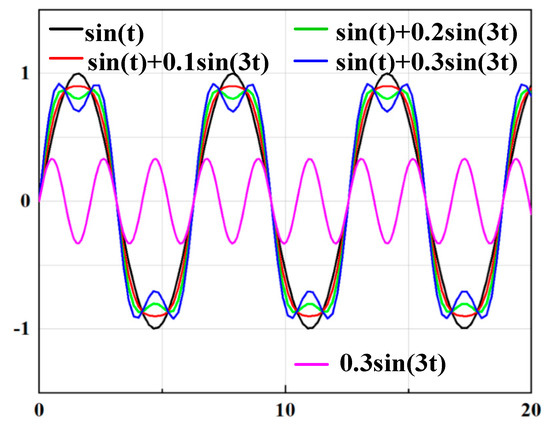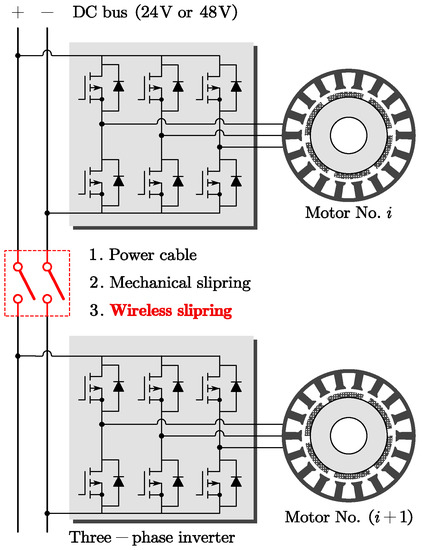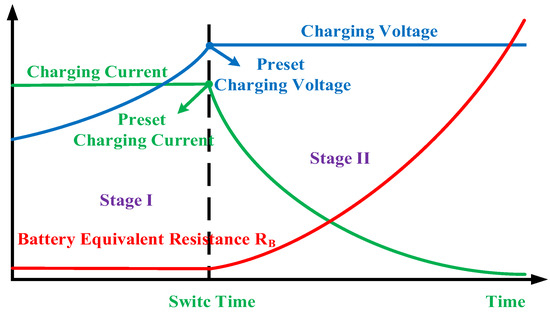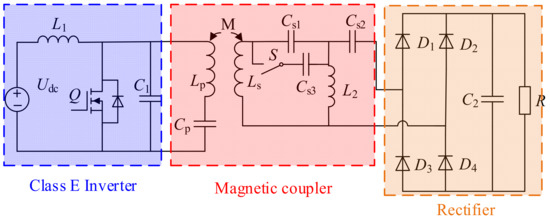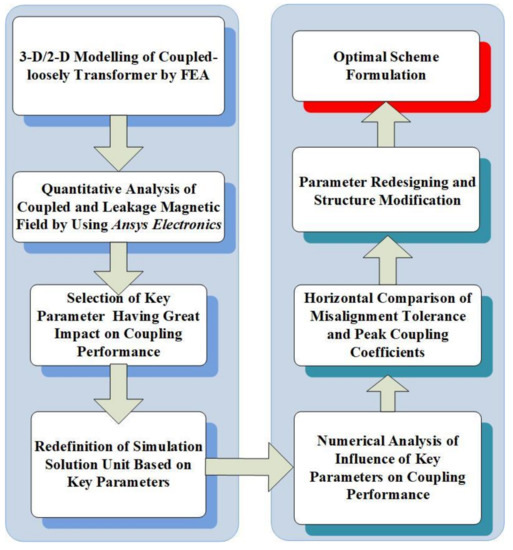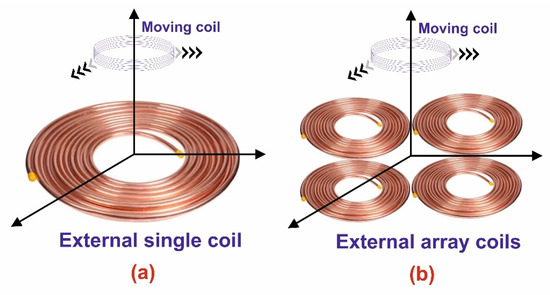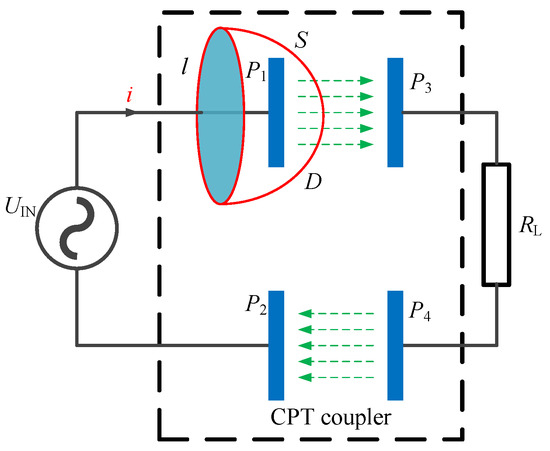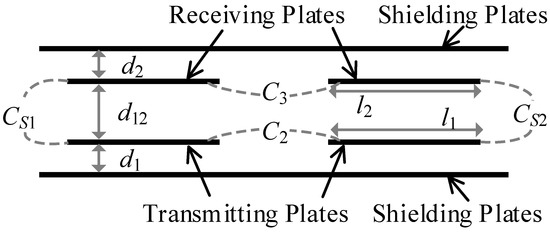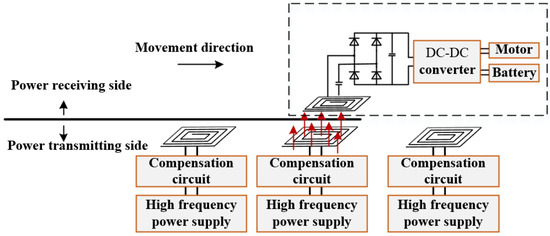<p>The fundamental and third harmonic frequencies’ superimposed wave cluster.</p> Full article ">Figure 2
<p>(<b>a</b>) Dual-frequency CPT system schematic. (<b>b</b>) Compensation unit model [<a href="#B27-electronics-12-01274" class="html-bibr">27</a>]. (<b>c</b>) Dual-frequency CPT system Π-type equivalent circuit model. (<b>d</b>) Dual-frequency CPT system T-type equivalent circuit model.</p> Full article ">Figure 3
<p>Relationship between normalized coupler voltage <math display="inline"><semantics> <mrow> <msubsup> <mi>V</mi> <mrow> <mi>m</mi> <mo>,</mo> <mi>d</mi> <mo>,</mo> <mi>m</mi> <mi>a</mi> <mi>x</mi> </mrow> <mo>*</mo> </msubsup> </mrow> </semantics></math> and power-sharing ratio <span class="html-italic">k</span>.</p> Full article ">Figure 4
<p>Relationship between normalized inverter conduction losses <math display="inline"><semantics> <mrow> <msubsup> <mi>P</mi> <mrow> <mi>i</mi> <mi>n</mi> <mi>l</mi> <mi>o</mi> <mi>s</mi> <mi>s</mi> <mo>,</mo> <mi>d</mi> </mrow> <mo>*</mo> </msubsup> </mrow> </semantics></math> and power-sharing ratio <math display="inline"><semantics> <mi>k</mi> </semantics></math>.</p> Full article ">Figure 5
<p>Design flowchart of the dual-frequency CPT system.</p> Full article ">Figure 6
<p>Experimental prototype of the proposed CPT system.</p> Full article ">Figure 7
<p>Experimental prototype of the proposed CPT system.</p> Full article ">Figure 8
<p>Waveforms of input voltage <math display="inline"><semantics> <mrow> <msub> <mi>v</mi> <mrow> <mi>i</mi> <mi>n</mi> </mrow> </msub> </mrow> </semantics></math>, input current <math display="inline"><semantics> <mrow> <msub> <mi>i</mi> <mrow> <mi>i</mi> <mi>n</mi> </mrow> </msub> </mrow> </semantics></math>, coupler voltage <math display="inline"><semantics> <mrow> <msub> <mi>v</mi> <mi>m</mi> </msub> </mrow> </semantics></math>, and output current <math display="inline"><semantics> <mrow> <msub> <mi>i</mi> <mrow> <mi>o</mi> <mi>u</mi> <mi>t</mi> </mrow> </msub> </mrow> </semantics></math> for the dual-frequency CPT system in the (<b>a</b>) simulation test and (<b>b</b>) experimental test.</p> Full article ">Figure 9
<p>Waveforms of (<b>a</b>) the coupler voltage <math display="inline"><semantics> <mrow> <msub> <mi>v</mi> <mi>m</mi> </msub> </mrow> </semantics></math> and (<b>b</b>) inverter output current <math display="inline"><semantics> <mrow> <msub> <mi>i</mi> <mrow> <mi>i</mi> <mi>n</mi> </mrow> </msub> </mrow> </semantics></math> for the proposed dual-frequency system and the equivalent single-frequency system.</p> Full article ">Figure 10
<p>System output power and efficiency versus <math display="inline"><semantics> <mrow> <msub> <mi>V</mi> <mrow> <mi>d</mi> <mi>c</mi> </mrow> </msub> </mrow> </semantics></math>.</p> Full article ">Figure 11
<p>Waveforms of input voltage <math display="inline"><semantics> <mrow> <msub> <mi>v</mi> <mrow> <mi>i</mi> <mi>n</mi> </mrow> </msub> </mrow> </semantics></math>, input current <math display="inline"><semantics> <mrow> <msub> <mi>i</mi> <mrow> <mi>i</mi> <mi>n</mi> </mrow> </msub> </mrow> </semantics></math>, coupler voltage <math display="inline"><semantics> <mrow> <msub> <mi>v</mi> <mi>m</mi> </msub> </mrow> </semantics></math>, and output current <math display="inline"><semantics> <mrow> <msub> <mi>i</mi> <mrow> <mi>o</mi> <mi>u</mi> <mi>t</mi> </mrow> </msub> </mrow> </semantics></math> after adding the rectifier structure.</p> Full article ">Figure 12
<p>The transformation from original load to multiple harmonics model.</p> Full article ">
